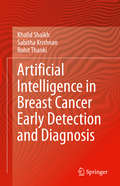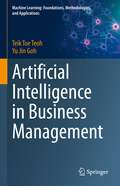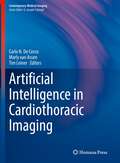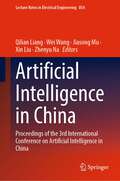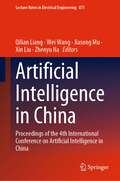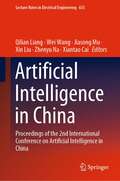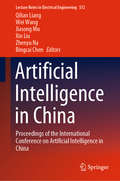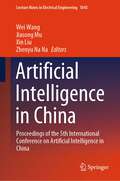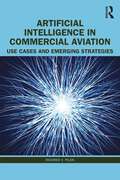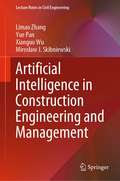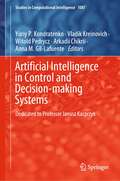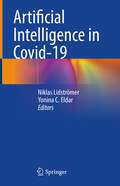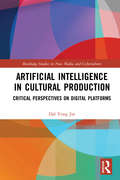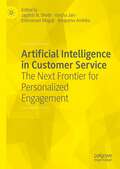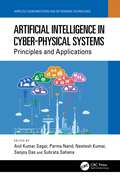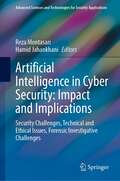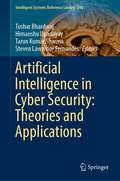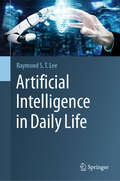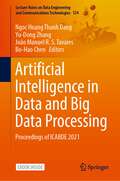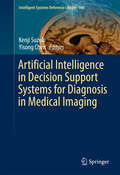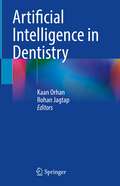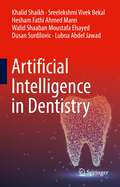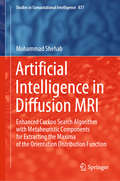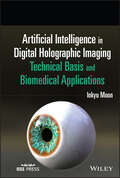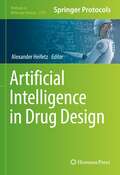- Table View
- List View
Artificial Intelligence in Breast Cancer Early Detection and Diagnosis
by Khalid Shaikh Sabitha Krishnan Rohit ThankiThis book provides an introduction to next generation smart screening technology for medical image analysis that combines artificial intelligence (AI) techniques with digital screening to develop innovative methods for detecting breast cancer. The authors begin with a discussion of breast cancer, its characteristics and symptoms, and the importance of early screening.They then provide insight on the role of artificial intelligence in global healthcare, screening methods for breast cancer using mammogram, ultrasound, and thermogram images, and the potential benefits of using AI-based systems for clinical screening to more accurately detect, diagnose, and treat breast cancer.Discusses various existing screening methods for breast cancerPresents deep information on artificial intelligence-based screening methods Discusses cancer treatment based on geographical differences and cultural characteristics
Artificial Intelligence in Business Management (Machine Learning: Foundations, Methodologies, and Applications)
by Teik Toe Teoh Yu Jin GohArtificial intelligence (AI) is rapidly gaining significance in the business world. With more and more organizations adopt AI technologies, there is a growing demand for business leaders, managers, and practitioners who can harness AI’s potential to improve operations, increase efficiency, and drive innovation. This book aims to help management professionals exploit the predictive powers of AI and demonstrate to AI practitioners how to apply their expertise in fundamental business operations. It showcases how AI technology innovations can enhance various aspects of business management, such as business strategy, finance, and marketing. Readers interested in AI for business management will find several topics of particular interest, including how AI can improve decision-making in business strategy, streamline operational processes, and enhance customer satisfaction. As AI becomes an increasingly important tool in the business world, this book offers valuable insights into how it can be applied to various industries and business settings. Through this book, readers will gain a better understanding of how AI can be applied to improve business management practices and practical guidance on how to implement AI projects in a business context. This book also provides practical guides on how to implement AI projects in a business context using Python programming. By reading this book, readers will be better equipped to make informed decisions about how to leverage AI for business success.
Artificial Intelligence in Cardiothoracic Imaging (Contemporary Medical Imaging)
by Carlo N. De Cecco Marly Van Assen Tim LeinerThis book provides an overview of current and potential applications of artificial intelligence (AI) for cardiothoracic imaging. Most AI systems used in medical imaging are data-driven and based on supervised machine learning. Clinicians and AI specialists can contribute to the development of an AI system in different ways, focusing on their respective strengths. Unfortunately, communication between these two sides is far from fluent and, from time to time, they speak completely different languages. Mutual understanding and collaboration are imperative because the medical system is based on physicians’ ability to take well-informed decisions and convey their reasoning to colleagues and patients.This book offers unique insights and informative chapters on the use of AI for cardiothoracic imaging from both the technical and clinical perspective. It is also a single comprehensive source that provides a complete overview of the entire process of the development and use of AI in clinical practice for cardiothoracic imaging. The book contains chapters focused on cardiac and thoracic applications as well more general topics on the potentials and pitfalls of AI in medical imaging. Separate chapters will discuss the valorization, regulations surrounding AI, cost-effectiveness, and future perspective for different countries and continents. This book is an ideal guide for clinicians (radiologists, cardiologists etc.) interested in working with AI, whether in a research setting developing new AI applications or in a clinical setting using AI algorithms in clinical practice. The book also provides clinical insights and overviews for AI specialists who want to develop clinically relevant AI applications.
Artificial Intelligence in China: Proceedings of the 3rd International Conference on Artificial Intelligence in China (Lecture Notes in Electrical Engineering #854)
by Qilian Liang Wei Wang Jiasong Mu Xin Liu Zhenyu NaThis book brings together papers presented at the 3rd International Conference on Artificial Intelligence in China (ChinaAI), which provides a venue to disseminate the latest developments and to discuss the interactions and links between these multidisciplinary fields. Spanning topics covering all topics in Artificial Intelligence with new development in China, this book is aimed at undergraduate and graduate students in Electrical Engineering, Computer Science and Mathematics, researchers and engineers from academia and industry as well as government employees (such as NSF, DOD, DOE, etc).
Artificial Intelligence in China: Proceedings of the 4th International Conference on Artificial Intelligence in China (Lecture Notes in Electrical Engineering #871)
by Qilian Liang Wei Wang Jiasong Mu Xin Liu Zhenyu NaThis book brings together papers presented at the 4th International Conference on Artificial Intelligence in China (ChinaAI), Changbaishan, China, on July 23-24, 2022, which provides a venue to disseminate the latest developments and to discuss the interactions and links between these multidisciplinary fields. Spanning topics covering all topics in Artificial Intelligence with new development in China, this book is aimed at undergraduate and graduate students in Electrical Engineering, Computer Science and Mathematics, researchers and engineers from academia and industry as well as government employees (such as NSF, DOD, DOE, etc).
Artificial Intelligence in China: Proceedings of the 2nd International Conference on Artificial Intelligence in China (Lecture Notes in Electrical Engineering #653)
by Qilian Liang Wei Wang Jiasong Mu Xin Liu Zhenyu Na Xiantao CaiThis book brings together papers presented at The 2nd International Conference on Artificial Intelligence in China (ChinaAI) 2020, which provides a venue to disseminate the latest developments and to discuss the interactions and links between these multidisciplinary fields. Spanning topics covering all topics in artificial intelligence with new development in China, this book is aimed at undergraduate and graduate students in Electrical Engineering, Computer Science and Mathematics, researchers and engineers from academia and industry as well as government employees (such as NSF, DOD and DOE).
Artificial Intelligence in China: Proceedings of the International Conference on Artificial Intelligence in China (Lecture Notes in Electrical Engineering #572)
by Qilian Liang Wei Wang Jiasong Mu Xin Liu Zhenyu Na Bingcai ChenThis book brings together papers presented at the International Conference on Artificial Intelligence in China (ChinaAI) 2019, which provided a venue for disseminating the latest advances and discussing the interactions and links between the various subfields of AI. Addressing topics that cover virtually all aspects of AI and the latest developments in China, the book is chiefly intended for undergraduate and graduate students in Electrical Engineering, Computer Science, and Mathematics, for researchers and engineers from academia and industry, and for government employees (e.g. at the NSF, DOD, and DOE).
Artificial Intelligence in China: Proceedings of the 5th International Conference on Artificial Intelligence in China (Lecture Notes in Electrical Engineering #1043)
by Wei Wang Jiasong Mu Xin Liu Zhenyu Na NaThis book brings together papers presented at the 2023 The International Conference on Artificial Intelligence in China (ChinaAI), which provides a venue to disseminate the latest developments and to discuss the interactions and links between these multidisciplinary fields. Spanning topics covering all topics in Artificial Intelligence with new development in China, this book is aimed at undergraduate and graduate students in Electrical Engineering, Computer Science and Mathematics, researchers and engineers from academia and industry as well as government employees (such as NSF, DOD, DOE).
Artificial Intelligence in Commercial Aviation: Use Cases and Emerging Strategies
by Ricardo V. PilonThis book is a must read for aviation managers and all stakeholders that are interested in improving the business performance of airlines. In this book, the first of its kind on AI in Commercial Aviation, the author outlines how Machine Learning and AI are accelerating and improving the performance of airlines. Moreover, the author shares insights into many new use cases that emerging technology can deliver. He tackles all crucial functions from air navigation, flight operations, to sales, distribution, cargo, retailing, and commercial optimization. He then looks forward to blockchain and the metaverse and its opportunities. With connected devices and the Internet of Everything (IoE), airlines can become retailers, sell, deliver, and service holistic experiences tailored to individuals in real time. This requires airlines to modernize processes and practices supported by decision intelligence (AI) that ingests sophisticated insights and executes service automation in real time. Transforming airlines from a production to a services-based execution also requires departments to be aligned along overriding customer experience and profitability goals. The book demonstrates how AI can be deployed to redesign airline organization as well. The author also describes the next wave of business transformation around the integration of commercial functions using Composite AI at enterprise level. With his holistic understanding and experience in the airline industry, the author provides valuable insights and helps managers understand how to embrace ML and AI and contribute to future commercial aviation and cargo success.
Artificial Intelligence in Construction Engineering and Management (Lecture Notes in Civil Engineering #163)
by Limao Zhang Yue Pan Xianguo Wu Mirosław J. SkibniewskiThis book highlights the latest technologies and applications of Artificial Intelligence (AI) in the domain of construction engineering and management. The construction industry worldwide has been a late bloomer to adopting digital technology, where construction projects are predominantly managed with a heavy reliance on the knowledge and experience of construction professionals. AI works by combining large amounts of data with fast, iterative processing, and intelligent algorithms (e.g., neural networks, process mining, and deep learning), allowing the computer to learn automatically from patterns or features in the data. It provides a wide range of solutions to address many challenging construction problems, such as knowledge discovery, risk estimates, root cause analysis, damage assessment and prediction, and defect detection. A tremendous transformation has taken place in the past years with the emerging applications of AI. This enables industrial participants to operate projects more efficiently and safely, not only increasing the automation and productivity in construction but also enhancing the competitiveness globally.
Artificial Intelligence in Control and Decision-making Systems: Dedicated to Professor Janusz Kacprzyk (Studies in Computational Intelligence #1087)
by Yuriy P. Kondratenko Vladik Kreinovich Witold Pedrycz Arkadii Chikrii Anna M. Gil-LafuenteThis book presents an authoritative collection of contributions reporting on computational intelligence, fuzzy systems as well as artificial intelligence techniques for modeling, optimization, control and decision-making together with applications and case studies in engineering, management and economic sciences. Dedicated to the Academician of the Polish Academy of Sciences, Professor Janusz Kacprzyk in recognition of his pioneering work, the book reports on theories, methods and new challenges in artificial intelligence, thus offering not only a timely reference guide but also a source of new ideas and inspirations for graduate students and researchers alike.The book consists of the 18 chapters, presented by distinguished and experienced authors from 16 different countries (Australia, Brazil, Canada, Chile, Germany, Hungary, Israel, Italy, China, R.N.Macedonia, Saudi Arabia, Spain, Turkey, United States, Ukraine, and Vietnam). All chapters are grouped into three parts: Computational Intelligence and Fuzzy Systems, Artificial Intelligence Techniques in Modelling and Optimization, and Computational Intelligence in Control and Decision Support Processes.The book reflects recent developments and new directions in artificial intelligence, including computation method of the interval hull to solutions of interval and fuzzy interval linear systems, fuzzy-Petri-networks in supervisory control of Markov processes in robotic systems, fuzzy approaches for linguistic data summaries, first-approximation analysis for choosing fuzzy or neural systems and type-1 or type-2 fuzzy sets, matrix resolving functions in game dynamic problems, evolving stacking neuro-fuzzy probabilistic networks and their combined learning in online pattern recognition tasks, structural optimization of fuzzy control and decision-making systems, neural and granular fuzzy adaptive modeling, state and action abstraction for search and reinforcement learning algorithms. Among the most successful and perspective implementations in practical areas of human activity are tentative algorithms for neurological disorders, human-centric question-answering system, OWA operators in pensions, evaluation of the perception of public safety through fuzzy and multi-criteria approach, a multicriteria hierarchical approach to investment location choice, intelligent traffic signal control and generative adversarial networks in cybersecurity.
Artificial Intelligence in Covid-19
by Yonina C. Eldar Niklas LidströmerThis book deals with the advantages of using artificial intelligence (AI) in the fight against the COVID-19 and against future pandemics that could threat humanity and our environment. This book is a practical, scientific and clinically relevant example of how medicine and mathematics will fuse in the 2020s, out of external pandemic pressure and out of scientific evolutionary necessity. This book contains a unique blend of the world's leading researchers, both in medicine, mathematics, computer science, clinical and preclinical medicine, and presents the research front of the usage of AI against pandemics. Equipped with this book the reader will learn about the latest AI advances against COVID-19, and how mathematics and algorithms can aid in preventing its spreading course, treatments, diagnostics, vaccines, clinical management and future evolution.
Artificial Intelligence in Cultural Production: Critical Perspectives on Digital Platforms (Routledge Studies in New Media and Cyberculture)
by Dal Yong JinThis book offers an in-depth academic discourse on the convergence of AI, digital platforms, and popular culture, in order to understand the ways in which the platform and cultural industries have reshaped and developed AI-driven algorithmic cultural production and consumption. At a time of fundamental change for the media and cultural industries, driven by the emergence of big data, algorithms, and AI, the book examines how media ecology and popular culture are evolving to serve the needs of both media and cultural industries and consumers. The analysis documents global governments’ rapid development of AI-relevant policies and identifies key policy issues; examines the ways in which cultural industries firms utilize AI and algorithms to advance the new forms of cultural production and distribution; investigates change in cultural consumption by analyzing the ways in which AI, algorithms, and digital platforms reshape people’s consumption habits; and examines whether governments and corporations have advanced reliable public and corporate policies and ethical codes to secure socio-economic equality. Offering a unique perspective on this timely and vital issue, this book will be of interest to scholars and students in media studies, communication studies, anthropology, globalization studies, sociology, cultural studies, Asian studies, and science and technology studies (STS).
Artificial Intelligence in Customer Service: The Next Frontier for Personalized Engagement
by Jagdish N. Sheth Varsha Jain Emmanuel Mogaji Anupama AmbikaThis edited volume elucidates how artificial intelligence (AI) can enable customer service to achieve higher customer engagement, superior user experiences, and increased well-being among customers and employees.As customer expectations dictate 24/7 availability from service departments and market pressures call for lower costs with higher efficiency, businesses have accepted that AI is vital in maintaining customer satisfaction. Yet, firms face tough challenges in choosing the right tool, optimizing integration, and striking the appropriate balance between AI systems and human efforts. In this context, chapters in this book capture the latest advancements in AI-enabled customer service through real-world examples. This volume offers a global perspective on this contemporary issue, covering topics such as the use of AI in enhancing customer well-being, data and technology integration, and customer engagement.
Artificial Intelligence in Cyber-Physical Systems: Principles and Applications (Wireless Communications and Networking Technologies)
by Sagar Anil KumarArtificial Intelligence (AI) and the Internet of Things (IoT) are growing rapidly in today’s business world. In today's era, 25 billion devices, including machines, sensors, and cameras, are connected and continue to grow steadily. It is assumed that in 2025, 41.6 billion IoT devices will be connected, generating around 79.4 zettabytes of data. IoT and AI are intersecting in various scenarios. IoT-enabled devices are generating a huge amount of data, and with the help of AI, this data is used to build various intelligent models. These intelligent models are helpful in our daily lives and make the world smarter. Artificial Intelligence in Cyber Physical Systems: Principles and Applications addresses issues related to system safety, security, reliability, and deployment strategies in healthcare, military, transportation, energy, infrastructure, smart homes, and smart cities.
Artificial Intelligence in Cyber Security: Security Challenges, Technical and Ethical Issues, Forensic Investigative Challenges (Advanced Sciences and Technologies for Security Applications)
by Reza Montasari Hamid JahankhaniThe book provides a valuable reference for cyber security experts, digital forensic practitioners and network security professionals. In recent years, AI has gained substantial attention from researchers in both academia and industry, and as a result AI’s capabilities are constantly increasing at an extraordinary pace. AI is considered to be the Fourth Industrial Revolution or at least the next significant technological change after the evolution in mobile and cloud computing technologies. AI is a vehicle for improving the quality of our lives across every spectrum with a broad range of beneficial applications in various sectors. Notwithstanding its numerous beneficial use, AI simultaneously poses numerous legal, ethical, security and privacy challenges that are compounded by its malicious use by criminals. These challenges pose many risks to both our privacy and security at national, organisational and individual levels.In view of this, this book aims to help address some of these challenges focusing on the implication, impact and mitigations of the stated issues. The book provides a comprehensive coverage of not only the technical and ethical issues presented by the use of AI but also the adversarial application of AI and its associated implications. The authors recommend a number of novel approaches to assist in better detecting, thwarting and addressing AI challenges. The book also looks ahead and forecasts what attacks can be carried out in the future through the malicious use of the AI if sufficient defences are not implemented. The research contained in the book fits well into the larger body of work on various aspects of AI and cyber security.It is also aimed at researchers seeking to obtain a more profound knowledge of machine learning and deep learning in the context of cyber security, digital forensics and cybercrime. Furthermore, the book is an exceptional advanced text for Ph.D. and master’s degree programmes in cyber security, digital forensics, network security, cyber terrorism and computer science. Each chapter contributed to the book is written by an internationally renowned expert who has extensive experience in law enforcement, industry or academia. Furthermore, this book blends advanced research findings with practice-based methods to provide the reader with advanced understanding and relevant skills.
Artificial Intelligence in Cyber Security: Theories and Applications (Intelligent Systems Reference Library #240)
by Tushar Bhardwaj Himanshu Upadhyay Tarun Kumar Sharma Steven Lawrence FernandesThis book highlights the applications and theory of artificial intelligence in the domain of cybersecurity. The book proposes new approaches and ideas to present applications of innovative approaches in real-time environments. In the past few decades, there has been an exponential rise in the application of artificial intelligence technologies (such as deep learning, machine learning, blockchain) for solving complex and intricate problems arising in the domain of cybersecurity. The versatility of these techniques has made them a favorite among scientists and researchers working in diverse areas. This book serves as a reference for young scholars, researchers, and industry professionals working in the field of Artificial Intelligence and Cybersecurity.
Artificial Intelligence in Daily Life
by Raymond S. LeeGiven the exponential growth of Artificial Intelligence (AI) over the past few decades, AI and its related applications have become part of daily life in ways that we could never have dreamt of only a century ago. Our routines have been changed beyond measure by robotics and AI, which are now used in a vast array of services. Though AI is still in its infancy, we have already benefited immensely. This book introduces readers to basic Artificial Intelligence concepts, and helps them understand the relationship between AI and daily life. In the interest of clarity, the content is divided into four major parts. Part I (AI Concepts) presents fundamental concepts of and information on AI; while Part II (AI Technology) introduces readers to the five core AI Technologies that provide the building blocks for various AI applications, namely: Machine Learning (ML), Data Mining (DM), Computer Vision (CV), Natural Languages Processing (NLP), and Ontology-based Search Engine (OSE). In turn, Part III (AI Applications) reviews major contemporary applications that are impacting our ways of life, working styles and environment, ranging from intelligent agents and robotics to smart campus and smart city projects. Lastly, Part IV (Beyond AI) addresses related topics that are vital to the future development of AI. It also discusses a number of critical issues, such as AI ethics and privacy, the development of a conscious mind, and autonomous robotics in our daily lives.
Artificial Intelligence in Data and Big Data Processing: Proceedings of ICABDE 2021 (Lecture Notes on Data Engineering and Communications Technologies #124)
by Ngoc Hoang Thanh Dang Yu-Dong Zhang João Manuel R. S. Tavares Bo-Hao ChenThe book presents studies related to artificial intelligence (AI) and its applications to process and analyze data and big data to create machines or software that can better understand business behavior, industry activities, and human health. The studies were presented at “The 2021 International Conference on Artificial Intelligence and Big Data in Digital Era” (ICABDE 2021), which was held in Ho Chi Minh City, Vietnam, during December 18-19, 2021. The studies are pointing toward the famous slogan in technology “Make everything smarter,” i.e., creating machines that can understand and can communicate with humans, and they must act like humans in different aspects such as vision, communication, thinking, feeling, and acting.“A computer would deserve to be called intelligent if it could deceive a human into believing that it was human” —Alan Turing
Artificial Intelligence in Decision Support Systems for Diagnosis in Medical Imaging (Intelligent Systems Reference Library #140)
by Kenji Suzuki Yisong ChenThis book offers the first comprehensive overview of artificial intelligence (AI) technologies in decision support systems for diagnosis based on medical images, presenting cutting-edge insights from thirteen leading research groups around the world. Medical imaging offers essential information on patients' medical condition, and clues to causes of their symptoms and diseases. Modern imaging modalities, however, also produce a large number of images that physicians have to accurately interpret. This can lead to an "information overload" for physicians, and can complicate their decision-making. As such, intelligent decision support systems have become a vital element in medical-image-based diagnosis and treatment. Presenting extensive information on this growing field of AI, the book offers a valuable reference guide for professors, students, researchers and professionals who want to learn about the most recent developments and advances in the field.
Artificial Intelligence in Dentistry
by Kaan Orhan Rohan JagtapThis comprehensive book focuses on various aspects of artificial intelligence in dentistry, assisting dentists, specialists, and scientists in advancing their understanding, knowledge, training, and expertise in this field of artificial intelligence. Readers will learn about AI-supported pathways for the diagnosis and treatment of dental caries, periodontal bone loss, impacted teeth, periapical lesions, crown, and root fractures, working length determination, and detecting root and canal morphology, TMJ disorders, detection of obstructive sleep apnea, oral mucosal lesions, and many more. Prediction tasks include the estimation of retreatment needs and third molar eruption. Critical information on applications of AI in the field of Oral and Maxillofacial Radiology, Implants, Endodontics, Prosthodontics, Restorative dentistry, Oral surgery, Periodontics, and Orthodontics. Gain valuable insight into studies applying machine learning based on Machine Learning (ML), Deep Learning (DL), and Artificial Neural Networks (ANN). Explore the technical aspects and medical applications of AI in dentistry. Additionally, discover cutting-edge topics like 3D and bioprinting applications of AI and its integration into dental education. All the chapters provide thorough, evidence-based data on AI and its implications in oral health, bridging the gap between knowledge and practical application. The book explains the advantages, disadvantages, and limitations of AI in dental health. Delve into the medico-legal aspects of AI to navigate this cutting-edge landscape responsibly. Learn about applications of Machine Learning and Artificial Intelligence in the Covid-19 Pandemic. Extensive information on deep learning in image processing, including various types of neural networks, image segmentation, enhancement, reconstruction, and registration. This book concludes with an exploration of AI's exciting potential and future perspectives in the dental field, paving the way for a new era of oral healthcare. Don't miss out on this unique resource for AI in Dentistry, which empowers you to stay at the forefront of innovation and embrace the AI revolution in Dentistry. Be prepared for the future of dentistry.
Artificial Intelligence in Dentistry
by Khalid Shaikh Sreelekshmi Vivek Bekal Hesham Fathi Marei Walid Shaaban Elsayed Dusan Surdilovic Lubna Abdel JawadThis book provides an introduction to next-generation applications and technologies for improving diagnostic accuracy and prediction of treatment outcomes in dentistry through the use of artificial intelligence (AI) and machine learning (ML). The authors attempt to bridge the gap between dental research and global health outcomes, as well as provide a comprehensive guide to general and clinical aspects of dental and oral health issues and the etiology, prevalence, assessment, and management of these conditions. This book combines engineering applications and medical healthcare and will be an important reference for researchers, biomedical engineers, dental students, and dental practitioners.
Artificial Intelligence in Diffusion MRI: Enhanced Cuckoo Search Algorithm with Metaheuristic Components for Extracting the Maxima of the Orientation Distribution Function (Studies in Computational Intelligence #877)
by Mohammad ShehabThis book focuses on the use of artificial intelligence to address a specific problem in the brain – the orientation distribution function. It discusses three aspects: (i) Preparing, enhancing and evaluating one of the cuckoo search algorithms (CSA); (ii) Describing the problem: Diffusion-weighted magnetic resonance imaging (DW-MRI) is used for non-invasive investigations of anatomical connectivity in the human brain, while Q-ball imaging (QBI) is a diffusion MRI reconstruction technique based on the orientation distribution function (ODF), which detects the dominant fiber orientations; however, ODF lacks local estimation accuracy along the path. (iii) Evaluating the performance of the CSA versions in solving the ODF problem using synthetic and real-world data. This book appeals to both postgraduates and researchers who are interested in the fields of medicine and computer science.
Artificial Intelligence in Digital Holographic Imaging: Technical Basis and Biomedical Applications (Wiley Series in Biomedical Engineering and Multi-Disciplinary Integrated Systems)
by Inkyu MoonArtificial Intelligence in Digital Holographic Imaging Technical Basis and Biomedical Applications An eye-opening discussion of 3D optical sensing, imaging, analysis, and pattern recognition Artificial intelligence (AI) has made great progress in recent years. Digital holographic imaging has recently emerged as a powerful new technique well suited to explore cell structure and dynamics with a nanometric axial sensitivity and the ability to identify new cellular biomarkers. By combining digital holography with AI technology, including recent deep learning approaches, this system can achieve a record-high accuracy in non-invasive, label-free cellular phenotypic screening. It opens up a new path to data-driven diagnosis. Artificial Intelligence in Digital Holographic Imaging introduces key concepts and algorithms of AI to show how to build intelligent holographic imaging systems drawing on techniques from artificial neural networks, convolutional neural networks, and generative adversarial network. Readers will be able to gain an understanding of the basics for implementing AI in holographic imaging system designs and connecting practical biomedical questions that arise from the use of digital holography with various AI algorithms in intelligence models. What’s Inside Introductory background on digital holography Key concepts of digital holographic imaging Deep-learning techniques for holographic imaging AI techniques in holographic image analysis Holographic image-classification models Automated phenotypic analysis of live cells For readers with various backgrounds, this book provides a detailed discussion of the use of intelligent holographic imaging system in biomedical fields with great potential for biomedical application.
Artificial Intelligence in Drug Design (Methods in Molecular Biology #2390)
by Alexander HeifetzThis volume looks at applications of artificial intelligence (AI), machine learning (ML), and deep learning (DL) in drug design. The chapters in this book describe how AI/ML/DL approaches can be applied to accelerate and revolutionize traditional drug design approaches such as: structure- and ligand-based, augmented and multi-objective de novo drug design, SAR and big data analysis, prediction of binding/activity, ADMET, pharmacokinetics and drug-target residence time, precision medicine and selection of favorable chemical synthetic routes. How broadly are these approaches applied and where do they maximally impact productivity today and potentially in the near future. Written in the highly successful Methods in Molecular Biology series format, chapters include introductions to their respective topics, lists of the necessary software and tools, step-by-step, readily reproducible modeling protocols, and tips on troubleshooting and avoiding known pitfalls. Cutting-edge and unique, Artificial Intelligence in Drug Design is a valuable resource for structural and molecular biologists, computational and medicinal chemists, pharmacologists and drug designers.
